UNDER THE SKIN: AUDI RS3 LMS TCR – THE STARTER PACK
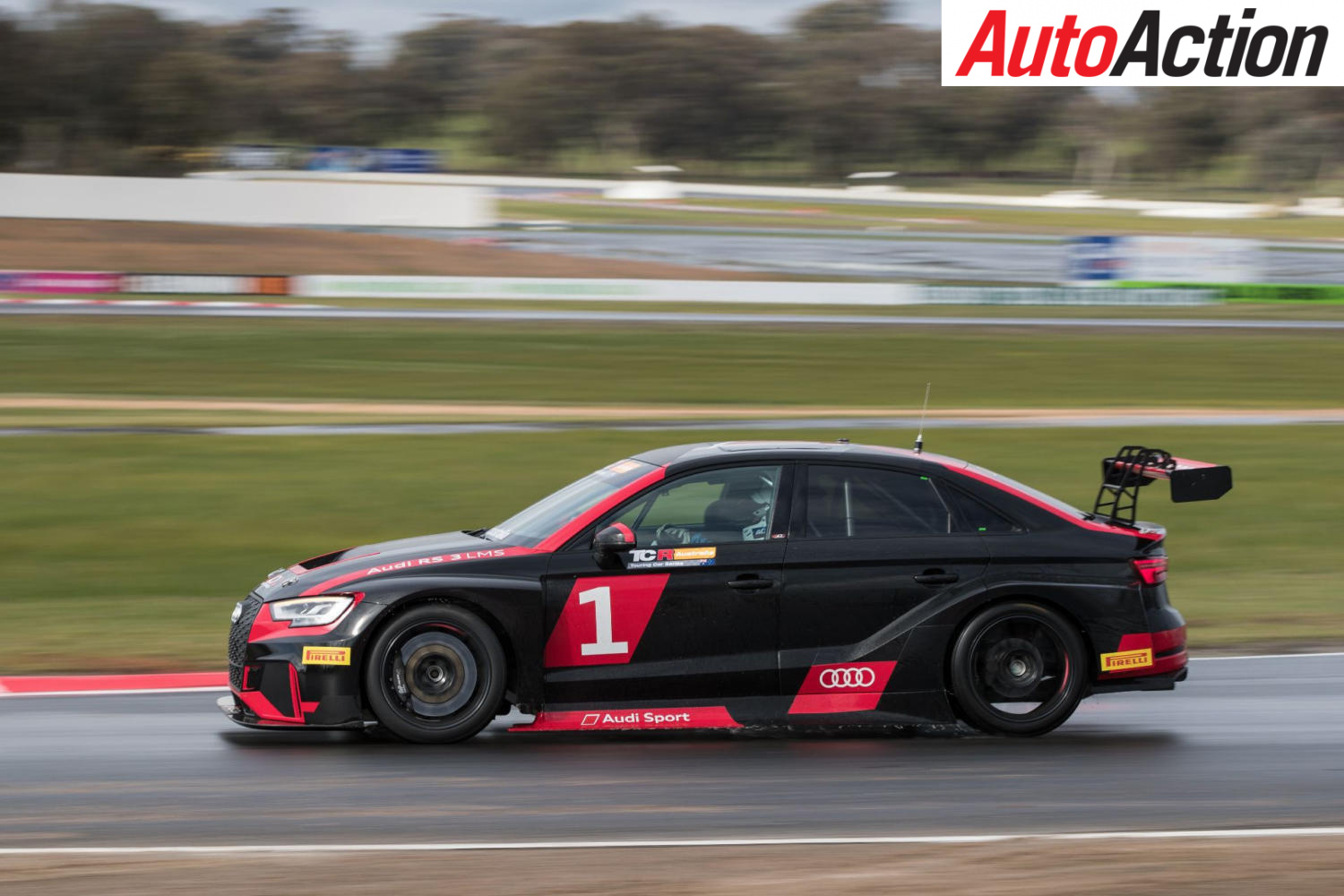

Under The Skin of Audi’s TCR racer
With CAMS sanctioning the TCR category for Australia, Auto Action takes a look under the skin of a current spec car, gets behind the wheel, and speaks to a man with some experience of them.
Over the past couple of years, Auto Action has covered the growth of TCR (Touring Car Racing) around the world. TCR has rapidly grown in popularity among your typical motorsport nations around the globe, with hundreds of races held across Europe, USA and Asia, and countries like China and Scandinavia are also getting involved.
Now that CAMS and the ARG group have confirmed that TCR will become a fully CAMS-sanctioned category beginning in 2019, we took the time to look under the skin of a current-spec TCR car and speak to a man with some experience of the cars, Audi Sport Customer Racing Australia managing director Lee Burley.
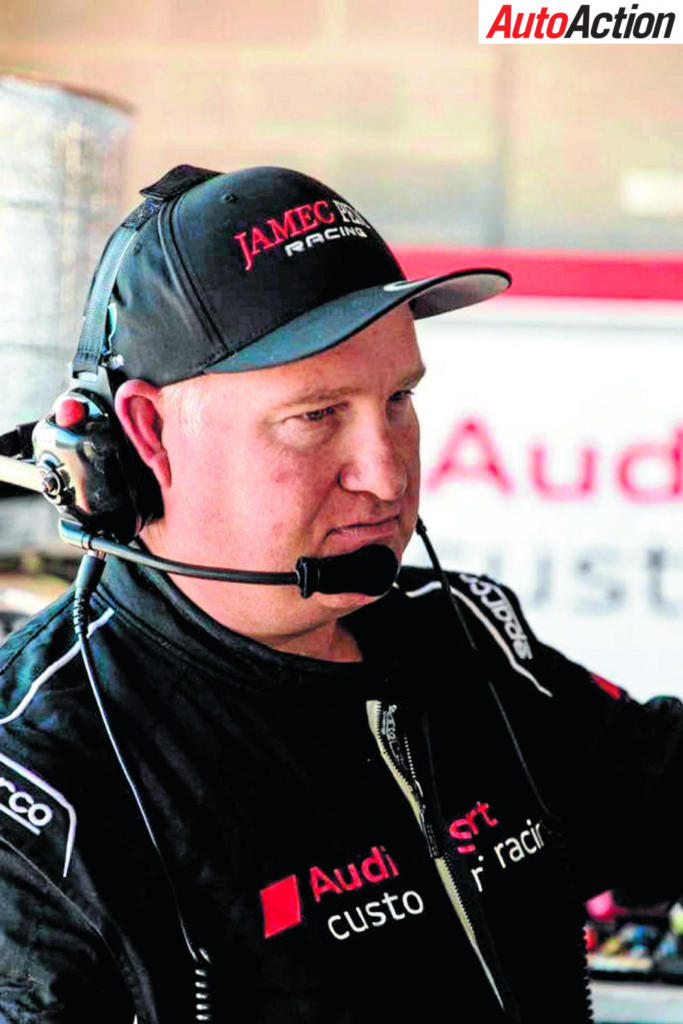
Audi Sport Customer Racing Australia managing director Lee Burley
While there are several manufacturers homologating and supplying race-ready cars to the TCR series, including Hyundai, Opel, Honda and Peugeot, a significant number of potential teams wanting to enter the category in Australia will look to purchase cars developed by Volkswagen Group Motorsport, which is represented in this country by Audi Sport Customer Racing Australia.
The Volkswagen Group Motorsport TCR race car programs have been developed along similar lines to the GT3/4 customer racing programs and supply several of its available models – the Audi RS3 LMS TCR, Volkswagen Golf GTI TCR and Cupra Leon TCR – for the various TCR series worldwide and the International Endurance Series.
With Burley and his team distributing these cars, they will no doubt be among the prime movers in the development of the latest touring car category to enter the Australian motorsport landscape.
Audi Customer Racing has built a reputation through its GT3 and subsequent GT4 programs. The German manufacturer’s latest model, the Audi RS3 LMS TCR, has been a success out of the box and, as the TCR wave hits the shores of Australia, Auto Action looked at what makes it a race winner.

Audi RS A3 LMS
The Audi A3 LMS TCR has already experienced much success in Europe. Double TCR International champion Stefano Comini may not make it a hat-trick this year, in the Audi’s first year of competition, but the Italian has taken three wins and five podiums in this year’s WTCR title race, which saw Hyundai dominate early in the season.
About 14 months ago, Audi imported an RS3 LMS TCR race car to support the release of the new Audi A3 road car range. The team at Audi Sport Customer Racing Australia ran the racecar for Audi in a series of track days, enabling plenty of local motoring journalists and a couple of high-profile race drivers to drive the purpose-built racecar. They provided plenty of enthusiastic feedback, though at the time TCR becoming a locally sanctioned category was a long way off.
The car was owned by Audi Germany and has recently been purchased by Audi Sport Customer Racing Australia in preparation for potential customer testing and evaluation for the kick-off of TCR Australia in 2019.

With that experience of running a TCR car and how it works, Lee Burley is now enthusiastic about the potential of TCR and the role it could play locally.
“I think the potential of the category is great, but like any new category the first year is going to be testing,” Burley told Auto Action.
He feels that TCR is a perfect addition to the Shannons Nationals, which will see an influx of new categories join the second-tier national series in 2019, and views TCR as a potential pathway to other categories.
“While it would be nice to race at some of the bigger events, we don’t need the Supercars crowds for it to work,” Burley said. “It will be great to have one or two races at major events if that’s the way it happens, but the Shannons series will be a great place for TCR to get going without a lot of costs. And it looks like the support categories on those events will be good next year. That’s where I see it ending up.
“I think if we can see around 16-car fields in the first year that will be really, really good. I think it needs to be over 20 (ultimately); whether that happens in the first year or second year we will see.
“Once there are some solid competitor numbers, and when you’ve got a category manager that has a bit of money to spend making things look flash and with better promotion, the commercial interest grows. I think there will be a need for that in the years to come because really any category at this level needs a bit of commercial interest to keep things going. “
When asked why he thought TCR could be successful in Australia, Burley responded with enthusiasm.
“The simple platform of the TCR car makes it an accessible category to join. As Audi Sport Customer Racing Australia, representing the Volkswagen Group Motorsport, we will carry the major parts, with only a few essentials required to get the car running, and we will support any teams that choose to run a car from the Volkswagen Group Motorsport family.
“I think these are really good race cars for a person with some basic racecar knowledge and skills, who can to turn up with a car on a trailer, a toolbox in the back of your van and go race.
“The key is you don’t have to bring any major parts – we carry those parts to the track for you. You will just need your wheels, tyres, a torque wrench, and an air bottle to jack the car up and down on the air jacks. There will be some other tools and so forth, but even software and the data logger are quite basic and simple to use. No expensive cables, no expensive software, it’s all usable right from there.
“These cars are relatively low-maintenance and the engine will do thousands of kilometres before it will need an inspection.
“I really hope there will be some teams that arrive on trailers and run them that way. For ourselves, we like to run the
cars for our customers who want a different experience.”
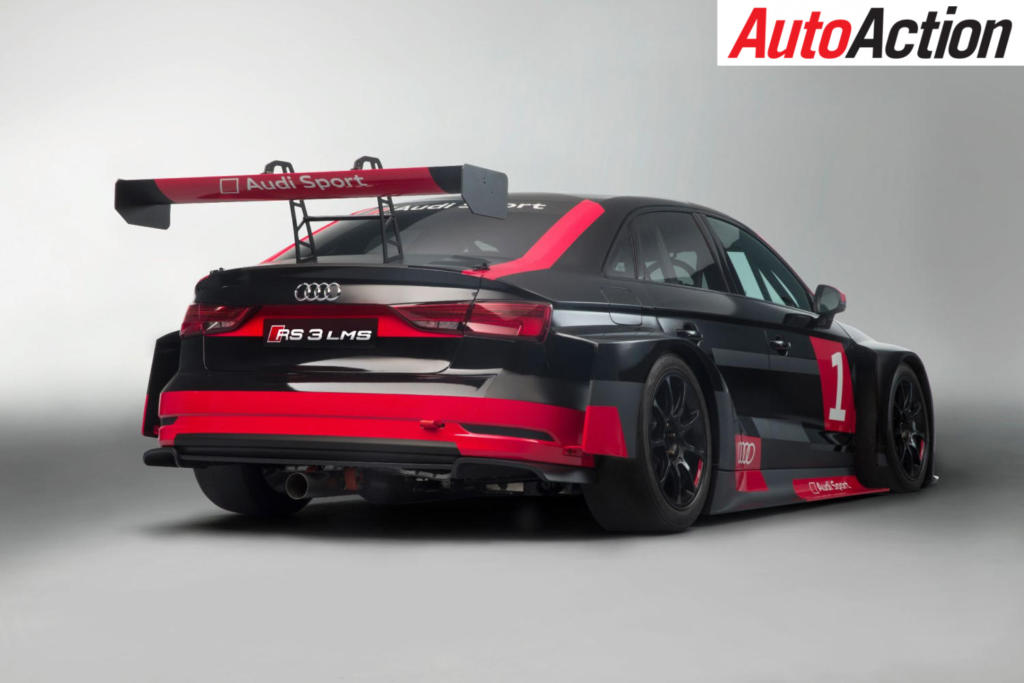
The support to TCR car owners is provided by Audi Sport Customer Racing Australia through a customer portal. This means that the Melbourne-based organisation will set up a TCR support program the same as the system it has in place for its various customers in the Australian GT Championship and GT Trophy, with everything from buying spare parts, car set-up windows and a section to sell used cars found in the one place.
“Everything is available to us in a portal from Volkswagen Group Motorsport,” Burley explained.
“There are PDMs for everything, giving you part numbers and descriptions, and all those parts will be available to us. We will hold a huge inventory of parts for all three manufacturers. The Cupra, the Volkswagen, and Audi.
“We’ll be carrying a huge amount of those parts and bodywork, similar to what we generally do in our GT3 program. We usually carry stock of two of each of the body parts in stock, so we can allow two of the same crashes of the one (type of) car. However, if we have an eight-car pile-up with the same manufacturer, things get a bit difficult.”
Burley is also optimistic that TCR will be a great category for young drivers who want to make a career in motorsport. The cars are all built to the same rules, and with the Balance of Performance in play, a driver who races well locally should be able to do the same in a car overseas. They could even take their own car and race in Asia or such.
With TCR already operating on our doorstep in Asia, Burley sees TCR as a launching pad for young drivers with a limited budget, and gives the opportunity to compete in other overseas racing.
“Maybe one day it will be a great stepping stone to Australian GT and Supercars, but it will be a while before it is perceived that way in Australia. But with TCR races being held all over the world, it’s an opportunity to race locally and gain experience and head overseas to race TCR with a heap of knowledge and skills, ready to take on the world of TCR.
“I think it’s a stepping stone to overseas TCR racing and GT racing in general. With the TCR rules all being the same around the world, there is the opportunity to showcase a driver’s talent to a worldwide audience and compete on equal footing outside Australia, which is a great thing for a young driver.
“In the overseas market, I think some drivers that have raced TCR locally could go overseas and drive a TCR in an endurance round, or another sprint series.
“A lot of our factory Audi drivers started in entry-level categories. Look at Christopher Mies – he started racing in a one-make Toyota Yaris series and won the series two years in a row. From that success he got picked up by Audi and is now one of their best factory drivers.”
Behind The Wheel
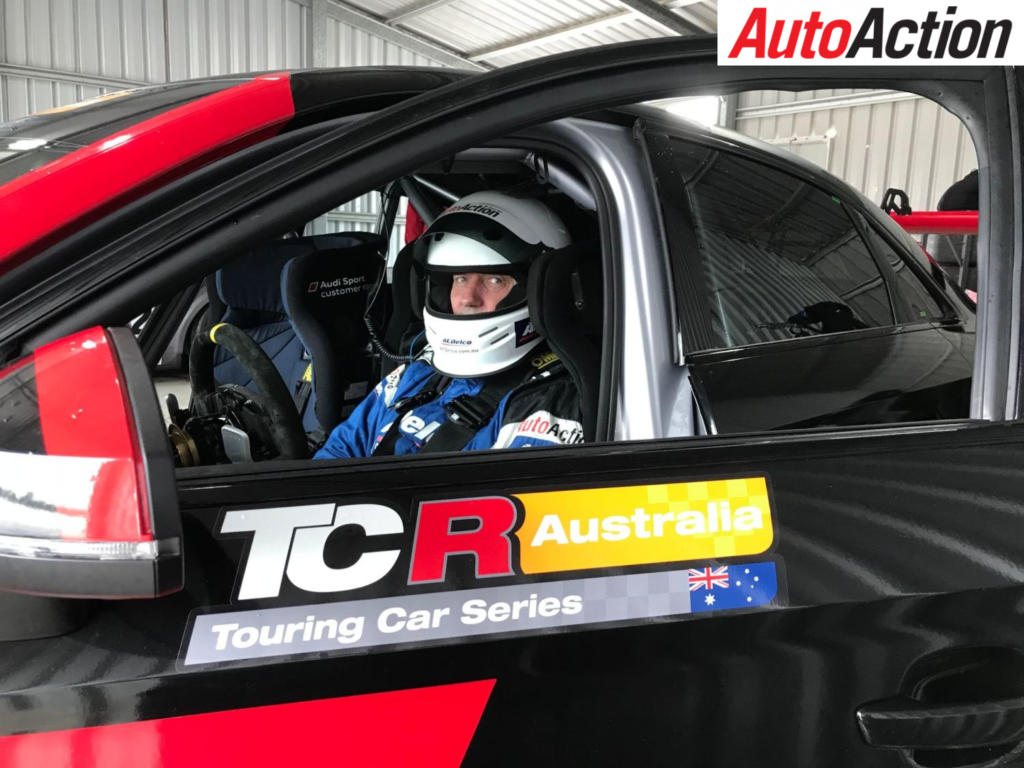
TCR Is coming to a race track near you… Well, that’s the plan if CAMS and the newly formed ARG organisation can come up with a confirmed series program and convince enough racers to get on board in what appears to be a race category with fantastic appeal and potential.
Most of what we know about these cars and the potential of the racing has come from what we have seen on the internet, TV and have read in the pages of publications such as Auto Action.
From the outside, the cars look fast and the racing is pretty much always spectacular. But why? Are they super-modified, massively powerful, or so high-tech that they need a factory-supported team to run them?
What are these cars really all about, and what are they like to drive?
Questions that most of us would like the answers to, so with an opportunity to sample a current-spec car, I decided to find out for myself.
The first thing that impressed me about the Audi RS3 LMS TCR is that it is a very well-engineered, purpose-built racecar, and while it is relatively inexpensive in motor racing terms it has many features that you would expect to see on a high-end GT3 car or another more expensive turn-key racecar. It is solid and it looks like it has been well thought out in most aspects.
This is a good-looking racecar, and the finish of bodywork of the car is what you would expect to see when you walk into an Audi dealership. It’s panel-perfect, and even the added boxy aero panels and side skirts – made from a combination of carbonfibre and fibreglass – look like they came from the factory. It looks a tough racecar and not a little unlike a mild DTM car or even a sports sedan.
This comment might sound a bit odd, but I think the Audi A3 LMS TCR is a nice-sized racecar and it doesn’t look like a little toy car, which was sort of what I was expecting. TCR regulations demand that the cars are based on a C-segment car, and that’s probably the size of car most peole are driving these days if they’re not in an SUV.
The car looks purposful, and has a solid feel to it. The roll cage is comprehensive, and it looks very safe. It has some other nice safety features, including a safety seat and a hatch in the roof to assist in the removal of a driver’s helmet if required after a racing incident.
Ergonomically, it is very well laid out, with a simple and clean cockpit. The dash looks standard apart from the racing additions, and the door panels are fully moulded around the roll-cage and side intrusion bars, all adding to the factory-finished look.
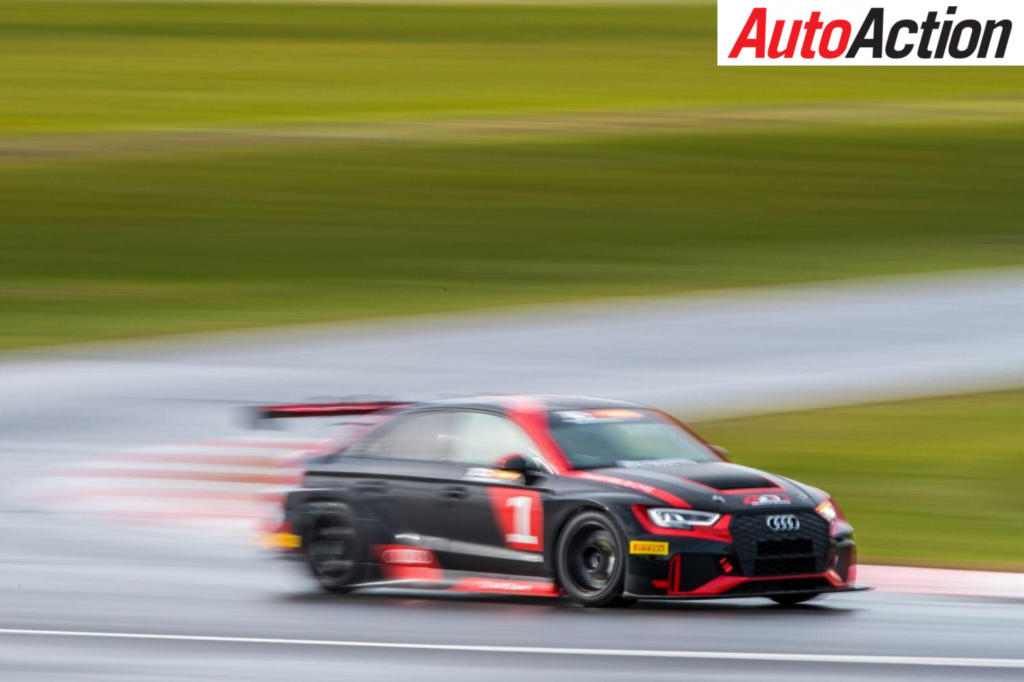
The car feels very comfortable straight away, with a great seating position that puts you very low in the car. However, the seat can easily be adjusted and, combined with the adjustable steering column, makes settling into a good driving position very easy.
The high-mounted pedal box with the brake, clutch and accelerator pedal, works well.
The car has some other nice features, like a big handbrake lever that is used to assist with starts, and has a fully plumbed onboard fire suppression system. Mounted behind the driver’s seat and inboard is an FIA FT3 100-litre fuel tank, with a dry-break refuelling system also an option.
The A3 LMS TCR on test is the highest spec of the three versions that Audi offer – the TCR SEQ – and features a Sadev six-speed sequential racing gearbox, with a sintered multi-disc racing clutch. The lower-spec RS3 LMS versions use a direct-shift gearbox (DSG) and the standard clutch system.
This car is fitted with unassisted non-ABS brakes featuring 378mm x 34mm rotors with monoblock four-piston AP Racing calipers on the front, with 272mm x 12mm rotors and two-piston calipers on the rear.
There is plenty of tunablity in the suspension, with two-way adjustable shock absorbers in the Macpherson strut front suspension (and sway bars), with adjustable shocks with coil-overs controlling the multi-link rear suspension.
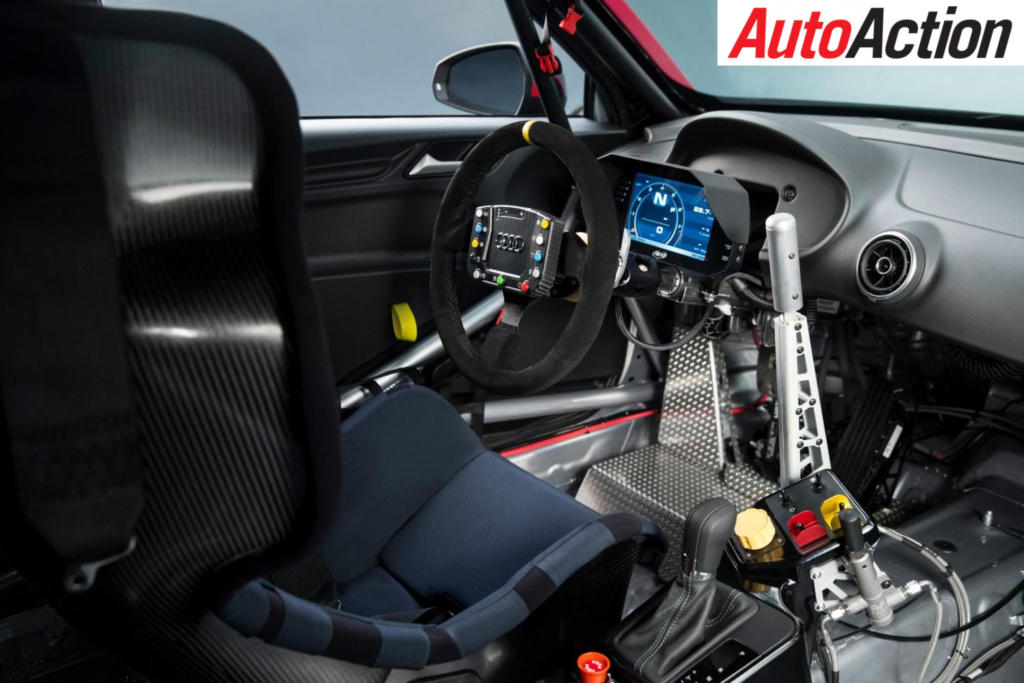
So, what’s it like to drive? Well, I know it’s going to be an interesting outing because this is the first time I have driven a left-hand-drive racecar, and the first front-wheel-drive racecar – a very different experience to driving my Touring Car Masters ACDelco Torana, which is a 600-horsepower V8, four-speed, rear-drive machine that weighs around 1450kg.
A very wet and slippery Winton Raceway was not the ideal place to get a good feel for the capabilities of a genuine current-spec TCR racecar, but it was an opportunity not to be missed so out I went.
As the car drops down from the air jacks, I use the clutch to select first gear, and it’s very light, with not a lot of feel. The clutch is only used for starting the car and to select neutral, as the gearshifts are all controlled via the ECU, which also has auto-blip for downshifts.
Out on the track I discovered that the power delivery is very linear, and the engine note dull, but it has no real turbo lag at all from the straight-four, turbocharged and intercooled engine, which is transversally mounted over the front axle.
While 243kW (330hp) at around 6200 rpm isn’t a lot of power, it keeps accelerating quickly through the gears, and there’s a very positive clunk with each upward gearchange. At no stage does the car feel slow.
What I notice the most is the noise of the paddle-shifted, electronically controlled gearbox, and while the upshifts were great, I wasn’t a fan when trying to downshift. I’m not sure if this car’s gearbox is near the end of its service life, but on a couple of occasions it doesn’t shift positively and has a long delay, causing me to get a little untidy under brakes.
Having not driven a front-wheel-drive racecar before, I wasn’t sure what to expect. Most front-drive road cars when pushed tend to understeer badly, and being on a wet track I assumed it would be even worse, but that was far from what I experienced on the track.
Both the chassis and suspension are really firm, the car feels like a real racecar, and even with the rain falling and on full wets the Audi has fantastic turn-in when attacking a medium to fast corner. When pushed hard in the slow corners, it starts to understeer under power, but once it grips up it accelerates surprisingly quickly for a car on a wet track.
The RS3 LMS works well for a car fitted with electric rack-and-pinion power steering, front-wheel drive and a mechanical limited-slip differential. It delivers great feel and feedback, and while the brake system has no ABS and is unassisted, the car stops well even on a wet track. The brakes are a feature and would be very powerful when more grip is on offer.
But, as seems the case with most front-wheel-drive racecars, getting any form of heat into the rear tyres is hard. On a wet track it is almost impossible, and that’s what I discovered at Winton; lift off too soon on turn-in to a corner and snap oversteer is the response.
As the laps built I started using left-foot braking to balance the car, trying not to lift off the throttle too much. This also helped with turn-in on the slow back part of the twisty Winton circuit and reduced the amount of snap oversteer.
After a few laps, and with an understanding of how the car responds, the pace started to build and the balance of the car improved as the tyres began to warm up. I started to see the potential in the car and I can only imagine how fast and how much fun it would be at fast, flowing tracks like Phillip Island and The Bend, with the aero working at high speed and 20 cars all at each other.
It was great fun and I now have a better understanding of what the fuss is all about. It was just shame it had to end.
So, to answer the question of what is a TCR car like? The fact is, this is a great racecar and the series should work. Why? Because the package seems to be right and it is producing good, close racing around the world, based on a solid, proven set of regulations that includes a ‘Balance of Performance’ factor.
With plenty of manufacturer-supported, well-built customer cars available to purchase, and with customer support on offer, there is no reason why TCR should not be a future Australian motorsport success story.
AUDI: RS3 LMS TCR

Engine
2.0-litre straight-four engine with turbocharger and intercooler
Power (max): 330hp @ 6200 rpm
Torque (max): 410Nm @ 2500 rpm
Transmission
Type: Front-wheel drive
SEQ: Six-speed sequential racing gearbox
Differential: Mechanical, preload adjustable
Clutch: Multi-disc, sintered
Cockpit
Seat: Audi Sport customer racing Seat PS-3 (FIA GT3 safety seat)
Controls: Height and reach-adjustable steering column with shift paddles on the steering wheel
Car Check: Control Auto-diagnosis OBDII / DiagRA-LE
Chassis
Front axle: MacPherson struts; height, track and camber of chassis can be adjusted; anti-roll bar can be adjusted in three stages
Rear axle: Multi-link axle, height, track and camber of chassis can be adjusted; anti-roll bar can be adjusted in three stages
Dampers: Adjustable
Steering: Electric rack-and-pinion with modified software and hardware
Front brakes: Discs (378mm x 34mm) with internal ventilation, aluminium six-piston calipers
Rear brakes: Discs (272mm x 12mm) with internal ventilation, two-piston calipers
Wheels: 10 x 18-inch
Bodywork
Structure: Strengthened production steel body with welded steel roll-cage
Bodywork: Parts from steel panel, CFC and GFC
Length: 4589mm
Width: 1950mm
Height: 1340mm
Fuel tank capacity: 100 litres
Wheelbase: 2665mm
Weight (empty): 1180kg
Minimum weight: 1285kg including driver (complying with TCR regulations)
Performance
Acceleration: 0-100km/h approx. 4.5 seconds
Top Speed: Approx. 240km/h
For Auto Action’s latest feature, pick up the latest issue of the magazine, on sale now. Also make sure you follow us on social media Facebook, Twitter, Instagram or our weekly email newsletter for all the latest updates between issues.


